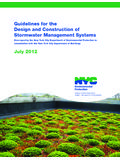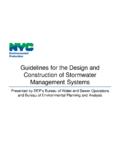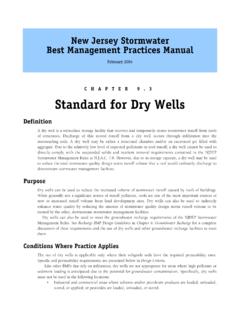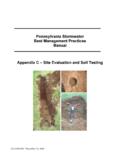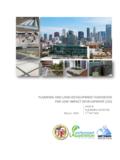Transcription of DRAFT Low Impact Development (LID) Stormwater …
1 April 2017 1 Ministry of the Environment & Climate Change DRAFT Low Impact Development (LID) Stormwater management Guidance Manual DRAFT Version April 20, 2017 DRAFTLID Stormwater management Guidance Manual DRAFT April 20, 2017 i DISCLAIMER The following document has been prepared based on expert input, stakeholder consultation and professional judgement; and represents a DRAFT document intended for distribution, review and comment by the Stakeholder Review Group (SRG), the Ministry of the Environment and Climate Change (MOECC) staff as well as other provincial agencies and organizations. This DRAFT document has not endorsed by the Ministry of the Environment and Climate Change (MOECC) and has been prepared for consideration only. DRAFTLID Stormwater management Guidance Manual DRAFT April 20, 2017 ii PREFACE During the past three decades, with improvements in watershed management and our understanding of the watersheds themselves, there has been an evolution in Stormwater management in Ontario.
2 Planners, engineers, landscape architects and designers now must address a broad suite of technical issues including the maintenance hydrologic processes and the natural water balance, as well as the enhancement of fish habitat, stream morphology, and terrestrial habitats and the mitigation of the observed and forecasted impacts of climate change. The most recent approaches and techniques used in Stormwater management (SWM) reflect our collective understanding and evolution and have lead to a change in the way in which the public and policy makers regard Ontario s water resources, the natural and human environments. This change, embodied within the principles of Green Infrastructure (GI) and Low Impact Development (LID), has led to considerable alterations in the planning, design and construction of Ontario communities and the infrastructure necessary to sustain them.
3 LID is an innovative state of the art approach to managing Stormwater by first and foremost treating runoff (precipitation) at its source, as a resource to be managed and protected rather than a waste. In this regard, the emphasis is to maintain the existing pre- Development water balance through the use of source (lot level) and conveyance measures in combination with end-of-pipe controls using what is referred to as a treatment train approach to Stormwater management . In keeping with these principles, a shift towards an ecosystem based water balance approach to Stormwater management has emerged and is being successfully applied. This approach has largely replaced the now outdated land use and infrastructure planning driven solely by rapid conveyance and public safety objectives using only grey infrastructure ( subsurface pipes) in combination with end-of-pipe controls.
4 However, it is no longer enough to simply apply LID and GI SWM approaches as part of land planning to simply mitigate impacts. To truly protect Ontario s water resources, the natural and human environments and preserve the ecological services already provided by our existing natural systems, these practices must be integrated into everyday urban forms, into the very fabric of the community. In this way, a complete and healthy community is formed whereby the very features which support the human inhabitants (roads, parks, grassed areas, sidewalks) become the very elements that protect the existing hydrologic features and function, create habitat, and make a community more livable. This Low Impact Development (LID) Stormwater management Guidance Manual should be used in conjunction with 2003 Stormwater management Planning and Design Manual (SWMPDM).
5 This manual, and its companion document, the 2003 SWMPDM, collectively provide the guidance and SWM criteria, necessary to implement a holistic treatment train approach to Stormwater management in Ontario using the full spectrum of source, conveyance and end-of-pipe controls. Echoing the 2003 SWMPDM, it is not the intent of the Ministry to limit innovation with this manual. Significant effort has been made to write the manual in a manner that does not inadvertently restrict creative solutions. The Ministry encourages the Development and application of innovative designs and technologies, where supported by literature, supporting research or other, when developed by a qualified person. Where the designer can show that alternate approaches can produce the desired results or even better, such designs should be considered.
6 However, the designer is responsible for the designs which are made with respect to Stormwater management for any given site. DRAFTLID Stormwater management Guidance Manual DRAFT April 20, 2017 iii ACKNOWLEDGEMENTS The following agencies, organizations, municipalities participated on Stakeholder Review Group (SRG) and generously provided their time and input into the preparation of this manual: Ontario Ministry of the Environment and Climate Change (MOECC) Johan Antoszek (PM) Henry Jun Robin Skeates Clara Tucker Sabrina Ternier Juwairia Obaid Robert Ulfig Nathalie Osipenko Magdi Widaatalla Barb McMurray Toronto and Region Conservation Authority (TRCA) Samir Dhalla Lake Simcoe Region Conservation Authority (LSRCA) Mike Walters Credit Valley Conservation (CVC) Christine Zimmer Conservation Ontario Jo-Anne Rzadki Ontario Ministry of Municipal Affairs Victor Doyle Charles O Hara Ontario Ministry of Transportation (MTO) Hani Farghaly Ontario Ministry of Natural Resources and Forestry (MNRF) Mark Heaton Municipal Engineers Association (MEA) Represented by.
7 Shawna Chambers and Scott Mathers City of London Water Environment Association of Ontario (WEAO) Dave Eadie Association of Municipalities Ontario (AMO) Craig Reid Institute of Catastrophic Loss (ICLR) Dan Sandink Green Infrastructure Ontario Coalition Clifford Maynes Landscape Ontario Tony DiGiovanni Alternates: Alex Zalewski and Sean James Building Industry and Land Development Association (BILD) and the Ontario Home Builder s Association (OHBA) Sarah Kurtz Steve Schaefer Jennifer Young Environment Canada Sandra Kok University of Guelph Andrea Bradford Ryerson University James Li Municipal Stormwater Discussion Group John Nemeth City of Ottawa Darlene Conway City of Kitchener Nick Gollan City of Toronto Patrick Cheung City of Calgary Bert Van Duin Other stakeholders participated in the workshops and provided input into the Development of this manual.
8 DRAFTLID Stormwater management Guidance Manual DRAFT April 20, 2017 iv The prime consultants for the project were Aquafor Beech Ltd. (Chris Denich (PM), Peter Hebert, Dave Maunder and Will Cowlin) and Earthfx Inc. ( Wexler and Pete Thompson). Technical expertise and review services were provided by Emmons and Oliver Resources (Jay Michels) and Sabourin and Associates Inc. (Jean-Francois Sabourin and Heather Wilson).DRAFTLID Stormwater management Guidance Manual DRAFT April 20, 2017 TABLE OF CONTENTS 1 Introduction .. 1 History of the MOECC Manuals .. 1 Present Day and This Manual .. 2 Supporting Resources .. 5 Manual 11 Effects of Urbanization .. 13 Discussion of Conventional SWM .. 14 Water Balance .. 15 Water Demand and Use .. 16 Introduction to GI and LID .. 16 LID BMPs and Approaches.
9 19 Benefits of Low Impact Development .. 29 LID 30 2 Environmental Planning Process .. 37 Ontario Land-Use Planning .. 37 SWM Plans in the Context of Watershed Studies .. 37 Role of the MOECC Manuals & Land Use Planning .. 39 SWM Legislative Context and LID Implementation .. 40 3 SWM Design Criteria: Runoff Volume Control Target .. 46 The 90th Percentile .. 46 Watershed Impervious Area .. 46 Background of the 90th Percentile .. 47 Rainfall Frequency Spectrums (RFS) .. 48 Determining the RVCT for Ontario .. 49 Definitions of Development .. 51 Runoff Volume Control Requirements .. 53 Exemptions .. 54 RVCT Mandatory Control Hierarchy .. 55 Post- Development Runoff Volume Control Target (RVRT) for 57 DRAFTLID Stormwater management Guidance Manual DRAFT April 20, 2017 Water Quality Expectations .. 60 Water Quantity Expectations.
10 61 4 Groundwater Considerations .. 62 Groundwater and Watershed Health .. 62 Groundwater Benefits from LIDs .. 63 Groundwater Risks from LIDs .. 63 High Risk Site Activities .. 68 Shallow and Deep Groundwater Systems .. 71 Groundwater/ Surface water Interaction and Water Quantity Risk .. 72 Infiltration and Groundwater Quality .. 73 Data Sources and Process for Determining Risks .. 73 Infiltration Guidelines .. 76 Designing for Minimal Impact on Groundwater Quality .. 77 5 Criteria for Model Selection .. 79 Assessing LID Performance with Models .. 80 Preserving Natural Hydrologic Function .. 81 Categorization of Model Types .. 81 Planning Level Tools .. 82 Class A: Water Balance Frameworks .. 82 Class B: Surface Water Runoff (Hydrologic) Models .. 91 Class C: Groundwater System Models .. 102 Class D: Loosely-coupled, coupled, and integrated groundwater/surface water models.





